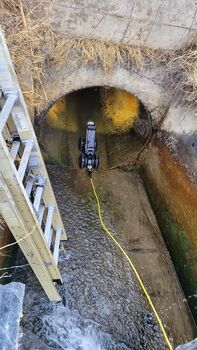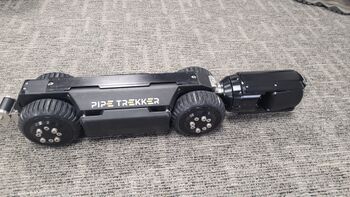Remotely Operated Vehicle Inspection: Difference between revisions
(Created page with "__NOTOC__ Category:Inspections ---- {{Picture <!-- Add image file name (ex.image.jpg) --> |image= Diga_di_Stramentizzo_drone.jpg <!--Add link if applicable --> |link= <!-- Add picture caption --> |caption= Drone photograph of Stramentizzo Dam, Italy. (Image Source: [https://commons.wikimedia.org/wiki/File:Diga_di_Stramentizzo_drone_04.jpg Wikimedia]) }} <!-- Delete any sections that are not necessary to your topic. Add pictures/sections as needed --> Remote dam...") |
No edit summary |
||
| Line 4: | Line 4: | ||
{{Picture | {{Picture | ||
<!-- Add image file name (ex.image.jpg) --> | <!-- Add image file name (ex.image.jpg) --> | ||
|image= | |image= Pipe Trekker Field.jpg | ||
<!--Add link if applicable --> | <!--Add link if applicable --> | ||
|link= | |link= | ||
<!-- Add picture caption --> | <!-- Add picture caption --> | ||
|caption= | |caption= Pipe Trekker A-Series entering pipe, preparing for inspection. | ||
( | }} | ||
{{Picture | |||
<!-- Add image file name (ex.image.jpg) --> | |||
|image= Pipe Trekker.jpg | |||
<!--Add link if applicable --> | |||
|link= | |||
<!-- Add picture caption --> | |||
|caption= Pipe Trekker A-Series. | |||
}} | }} | ||
<!-- Delete any sections that are not necessary to your topic. Add pictures/sections as needed --> | <!-- Delete any sections that are not necessary to your topic. Add pictures/sections as needed --> | ||
Remote dam | Remote Operated Vehicles (ROVs) can be used to inspect areas around a dam that are difficult to access or present safety hazards to inspectors. Three types of ROVs are commonly used: Submersible ROVs, Pipe Crawler ROVs, and Unmanned Aerial Vehicles (UAVs). | ||
===== '''Submersible ROVs''' ===== | |||
Underwater ROV [[inspections]] facilitate inspection of the submerged portions of a dam without the need for divers. The submersible equipment is quite expensive and specialty contractors are typically required to utilize this technology. In 2007, the US Army Corps of Engineers published the results of a demonstration project titled “Demonstration of Remotely Operated Vehicles to Aid Underwater Inspection of Corps of Engineers [[Navigation]] Structures (ERDC/CRREL TR-08-15)” which provides more details about this technology and where it might be useful. | |||
===== '''Pipe Crawler ROVs''' ===== | |||
Pipe Crawler ROVs can be utilized to inspect outlet conduits that pose confined space hazards or are too small for personnel to enter. Most regions of the United States have contractors with this type of equipment available, and some municipalities have their own equipment. Key requirements of the equipment include real-time video feed to the operator, adequate lighting, pan/zoom ability and adequate traction for the crawler to negotiate steep and [[Slippery Surfaces|slippery surfaces]]. An armature capable of holding the camera in the center of the pipe is also helpful.<br> | |||
The size of the equipment is also important. Many traditional pipe crawlers are operated out of a large panel van. Recent advances in the technology has resulted in significant reduction in equipment size. An example is the Pipe Trekker A-Series system which can be packages in two pelican-style cases weighing approx. 50-lb each. This allows the ROV to be transported to remote locations that traditionally have been inaccessible. | |||
===== '''Unmanned Aerial Vehicles (UAV)''' ===== | |||
UAVs are typically quad-coptors that can be equipped with high-resolution cameras, thermal imaging sensors, LiDAR systems, and other specialized equipment to capture detailed visual data of the dam and its surrounding areas. Data collection with UAVs can help dam officials evaluate [[structural]] integrity, erosion patterns, vegetation growth, and other potential issues that may affect the dam's [[stability]]. Drones may also be used to remotely observe dams when direct access would prove too risky for human access, such as developing failure modes. Surveys can also be conducted following dam failure when access may no longer be safe or available.<br> | |||
During a UAV inspection, a trained operator, licensed by the Federal Aviation Administration, remotely controls the drone, or directly oversees the individual operating the drone, maneuvering it around the dam to capture visual and/or thermal images from various angles and altitudes. The collected data is then transmitted in real-time to the operator, where inspectors can view the footage, analyze it for potential concerns, or direct the operator to navigate the drone to gain other perspectives on the area. Ideally, the inspection team would also include a Visual Observer, whose role it is to keep the drone within line of sight during the inspection. <br> | |||
Data obtained from drone inspections allows inspectors to identify cracks, seepage, deformation, or settlements in the dam structure. Thermal imaging sensors can detect temperature variations, highlighting potential areas of seepage. Drone inspections can also be used to visually assess areas that are difficult to access or involve risk to humans, such as inspections that require fall protection.<br> | |||
LiDAR and aerial [[photogrammetry]] systems can be mounted on drones, to create detailed 3D maps of the dam and its surroundings. This data provides accurate measurements of the dam and allows inspectors to assess the topography, identify erosion patterns, and detect any structural deformations. Drone collected surfaces can also be used to confirm as-constructed conditions and quantify material take-off volumes.<br> | |||
UAV inspections have limitations that in-person inspections do not have. Their [[operation]] depends on weather conditions, as wind and [[precipitation]] events restrict drone operations. Other restrictions apply, such as proximity to airports, flights over people or near sensitive wildlife, flights within National and sometimes State Parks, etc. Drone pilots are encouraged to review restrictions specific to the State they are operating within.<br> | |||
UAV pilots require specialized training and certification by the [https://www.faa.gov/uas/commercial_operators/become_a_drone_pilot Federal Aviation Administration (FAA)] under part 107.<br> | |||
UAVs must be operated within specified limits as determined by the FAA.<br> | |||
Data privacy concerns with UAVs manufactured outside of the US may be a concern for certain dam owners. | |||
Latest revision as of 00:09, 18 January 2024

|
| Pipe Trekker A-Series entering pipe, preparing for inspection. |

|
| Pipe Trekker A-Series. |
Remote Operated Vehicles (ROVs) can be used to inspect areas around a dam that are difficult to access or present safety hazards to inspectors. Three types of ROVs are commonly used: Submersible ROVs, Pipe Crawler ROVs, and Unmanned Aerial Vehicles (UAVs).
Submersible ROVs
Underwater ROV inspections facilitate inspection of the submerged portions of a dam without the need for divers. The submersible equipment is quite expensive and specialty contractors are typically required to utilize this technology. In 2007, the US Army Corps of Engineers published the results of a demonstration project titled “Demonstration of Remotely Operated Vehicles to Aid Underwater Inspection of Corps of Engineers Navigation Structures (ERDC/CRREL TR-08-15)” which provides more details about this technology and where it might be useful.
Pipe Crawler ROVs
Pipe Crawler ROVs can be utilized to inspect outlet conduits that pose confined space hazards or are too small for personnel to enter. Most regions of the United States have contractors with this type of equipment available, and some municipalities have their own equipment. Key requirements of the equipment include real-time video feed to the operator, adequate lighting, pan/zoom ability and adequate traction for the crawler to negotiate steep and slippery surfaces. An armature capable of holding the camera in the center of the pipe is also helpful.
The size of the equipment is also important. Many traditional pipe crawlers are operated out of a large panel van. Recent advances in the technology has resulted in significant reduction in equipment size. An example is the Pipe Trekker A-Series system which can be packages in two pelican-style cases weighing approx. 50-lb each. This allows the ROV to be transported to remote locations that traditionally have been inaccessible.
Unmanned Aerial Vehicles (UAV)
UAVs are typically quad-coptors that can be equipped with high-resolution cameras, thermal imaging sensors, LiDAR systems, and other specialized equipment to capture detailed visual data of the dam and its surrounding areas. Data collection with UAVs can help dam officials evaluate structural integrity, erosion patterns, vegetation growth, and other potential issues that may affect the dam's stability. Drones may also be used to remotely observe dams when direct access would prove too risky for human access, such as developing failure modes. Surveys can also be conducted following dam failure when access may no longer be safe or available.
During a UAV inspection, a trained operator, licensed by the Federal Aviation Administration, remotely controls the drone, or directly oversees the individual operating the drone, maneuvering it around the dam to capture visual and/or thermal images from various angles and altitudes. The collected data is then transmitted in real-time to the operator, where inspectors can view the footage, analyze it for potential concerns, or direct the operator to navigate the drone to gain other perspectives on the area. Ideally, the inspection team would also include a Visual Observer, whose role it is to keep the drone within line of sight during the inspection.
Data obtained from drone inspections allows inspectors to identify cracks, seepage, deformation, or settlements in the dam structure. Thermal imaging sensors can detect temperature variations, highlighting potential areas of seepage. Drone inspections can also be used to visually assess areas that are difficult to access or involve risk to humans, such as inspections that require fall protection.
LiDAR and aerial photogrammetry systems can be mounted on drones, to create detailed 3D maps of the dam and its surroundings. This data provides accurate measurements of the dam and allows inspectors to assess the topography, identify erosion patterns, and detect any structural deformations. Drone collected surfaces can also be used to confirm as-constructed conditions and quantify material take-off volumes.
UAV inspections have limitations that in-person inspections do not have. Their operation depends on weather conditions, as wind and precipitation events restrict drone operations. Other restrictions apply, such as proximity to airports, flights over people or near sensitive wildlife, flights within National and sometimes State Parks, etc. Drone pilots are encouraged to review restrictions specific to the State they are operating within.
UAV pilots require specialized training and certification by the Federal Aviation Administration (FAA) under part 107.
UAVs must be operated within specified limits as determined by the FAA.
Data privacy concerns with UAVs manufactured outside of the US may be a concern for certain dam owners.
